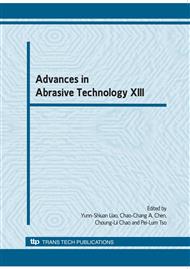[1]
M.Y. Noordin, V.C. Venkatesh, S. Sharif, S. Elting, A. Abdullah: Application of response surface methodology in describing the performance of coated carbide tools when turning AISI 1045 steel. Journal of Materials Processing Technology, Vol 145, Issue 1, 1 (2004).
DOI: 10.1016/s0924-0136(03)00861-6
Google Scholar
[2]
S. Kalpakjian, S.R. Schmid: Manufacturing Processes for Engineering Materials, 4 th edition, Pearson Education Inc (2001).
Google Scholar
[3]
M.A.Y. Gonzalez and H.K.D.H. Bhadeshia: Cast Iron, http: /msm. cam. ac. uk/phasetrans/2001/adi/cast. iron. html, on line 08/08/(2007).
Google Scholar
[4]
G.M. Goodrich: Case histories of cast iron machinability problems, http: /www. allbusiness. com/manufacturing/fabricated-metal-product-manufacturing/6307351. html on line 08/08/(2007).
Google Scholar
[5]
R.D. Griffin, H.J. Li, E. Eleftheriou, C.E. Bates: Machinability of Gray Cast Iron, University of Alabama, Birmingham, Alabama. http: /www. atlasfdry. com/machinability. htm online 21/01/(2010).
Google Scholar
[6]
T. Ozel, T. Altan: Determination of workpiece flow stress and friction at the chip-tool contact for high-speed cutting, Int. J. Machine Tools and Manufacture. Vol 40, Issue 1, (2000), pp.133-152.
DOI: 10.1016/s0890-6955(99)00051-6
Google Scholar
[7]
A.K. Ghani, I.A. Choudhury, and Husni : Study of tool life, surface roughness and vibration in machining nodular cast iron with ceramic tool, Journal of Materials Processing Technology Vol 127 (2000) pp.17-22.
DOI: 10.1016/s0924-0136(02)00092-4
Google Scholar
[8]
V. Solaja, M.C. Shaw: Wear of carbide tools and surface finish generated in finish turning of steel, in: Proceedings of the First International MTDR Conference, Vol. 2 (1984), pp.40-58.
DOI: 10.1016/0043-1648(58)90339-9
Google Scholar
[9]
SIRIM (National Centre for Machinery & Tooling Technology) (2009).
Google Scholar
[10]
M.C. Shaw: Metal Cutting Principles. New York, Oxford University Press (1986).
Google Scholar
[11]
A.E. Diniz, A. Jose´ de Oliveira: Optimizing the use of dry cutting in rough turning steel operations. International Journal of Machine Tools & Manufacture 44 (2004), pp.1061-1067.
DOI: 10.1016/j.ijmachtools.2004.03.001
Google Scholar
[12]
M. Kamruzzaman, N.R. Dhar, 2008. The effect of applying high-pressure coolant (hpc) jet in Machining of 42crmo4 steel by uncoated carbide inserts. Journal of Mechanical Engineering, Vol. ME39, No. 2, (2008), pp.71-77.
DOI: 10.3329/jme.v39i2.1849
Google Scholar
[13]
V.P. Astakhov, S.V. Shvets. 2004. The assessment of plastic deformation in metal cutting. Journal of Material Process Technology 146: 193 - 202.
DOI: 10.1016/j.jmatprotec.2003.10.015
Google Scholar
[14]
P. Davim, V.N. Gaitondeb & S.R. Karni: Investigations into the effect of cutting conditions on surface roughness in turning of free machining steel by ANN models. Journal Of Materials Processing Technology 203 (2008), pp.95-101.
DOI: 10.1016/j.jmatprotec.2007.11.082
Google Scholar
[15]
A.I. Gusri, C.H. Che Hassan, A.G. Jaharah, B. Yanuar, A. Yasir, A. & A. Nagi: Application Of Taguchi Method In Optimizing Turning Parameters Of Titanium Alloy. Seminar on Engineering Mathematics Engineering Mathematics Group (2008).
Google Scholar
[16]
M. Thomas, Y. Beauchamp, A.Y. Youssef and J. Masounave, An experimental design for surface roughness and built-up edge formation in lathe dry turning. International Journal of Quality Science 2 3 (1997), pp.167-180.
DOI: 10.1108/13598539710170803
Google Scholar
[17]
A. Bhattacharyya: Metal Cutting - Theory and practice. Calcutta, Central Book Publishers (1984).
Google Scholar
[18]
I. Korkut, K. Yavuz & Y. Turgut: An experimental investigation into machinability of GGG-70 grade spheroidal graphite cast iron. Indian Journal Of Engineering And Materials Sciences 16: 2(2009), pp.116-122.
Google Scholar
[19]
J.A. Ghani, I.A. Choudhury, H.H. Hassan, 2004, Application of Taguchi method in the optimizationof end milling parameters, Journal of Materials Processing Technology 145 (2004), pp.84-92.
DOI: 10.1016/s0924-0136(03)00865-3
Google Scholar
[20]
J.A. Ghani, I.A. Choudhury, H.H. Masjuki: Performance of P10 TiN coated carbide tools when end milling AISI H13 tool steel at high cutting speed, Journal of Materials Processing Technology 153-154 (2004), pp.1062-1066.
DOI: 10.1016/j.jmatprotec.2004.04.353
Google Scholar


